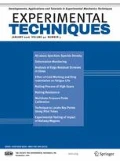Abstract
This paper compares two novel motion capture systems using several biomechanical measurements during walking operations under various conditions. The first one is CATRASYS (“Cassino tracking system”) that was initially used as motion capture system applied to Robotics since 1994 at the Cassino University. The second one is the commercial Kinect™ system, which consists of a depth sensor and specific software, and can detect and track human forms. This paper studies problems and experiences in using both measuring systems through a comparison of results obtained from their use. It also enables characterization of walking operations by means of a model based on the paths of the ankle and knee points.
Similar content being viewed by others
References
Villa, A., Gutiérrez, E., and Pérez, J.C., “Considerations for the Analysis Of Human Walking: Videogrammetry, Electromyography and Dynamometry (In Spanish),” Revista Ingeniería Biomedica 2(3): 16–26 (2008).
Panero, J. and Zelnik, M. Human Dimension & Interior Space, Whitney Library of Design, New York (1979).
Font-Llagunes, J.M., and Kövecses, J., “Efficient Dynamic Walking: Design Strategies to Reduce Energetic Losses of a Compass Walker at Heel Strike,” Mechanics Based Design of Structures and Machines 37(3): 259–282 (2009).
Lindner, M., Kotschwar, A., Zsoldos, R.R., Groesel, M., and Peham, C., “The Jump Shot – A Biomechanical Analysis Focused on Lateral Ankle Ligaments,” Journal of biomechanics 45(1): 202–206 (2012).
Rodrigo, S.E., Ambrósio, J.A.C., Tavares, M.P., and Penisi, O.H., “Analysis of Human Gait Based on Multibody Formulations and Optimization Tools,” Mechanics Based Design of Structures and Machines 36(4): 446–477 (2008).
Acosta, C.A., Mohan, R.E., Hu, L., Zhou, C., and Hu, H., “Generating Human-Like Soccer Primitives from Human Data,” Robotics and Autonomous Systems 57(8): 860–869 (2009).
Van der Smagt, P., Grebenstein, M. and Urbanek, H., et al., “Robotics of Human Movements,,” Journal of physiology 103(3–5): 119–132 (2009).
Farris, D.A., Urquizo, G.C., Beattie, D.K., Woods, T.O., and Berghaus, D.G., “A Simplified Accelerometer System for Analysis of Human Gait,” Experimental Techniques 17(1): 33–36 (2008).
Miller, J.D., Beazer, M.S., and Hahn, M.E., “Myoelectric Walking Model Classification for Transtibial Amputees,” IEEE Transactions on Biomedical Engineering 60(10): 2745–2750 (2013).
Martín, R., Postigo, S., Ezquerro, F., and Blanca, A.D.L., “Kinematic and Dynamic Analysis of Knee Articulation in High Demand Exercises: Climbing Down Stairs and Turning (In Spanish),” Anales de Ingeniería Mecánica 18: 1–9 (2010).
Royo, A.C., Aguilar, J.J., Santolaria, J., and Mart´ınez, M.A. “Analysis, Experimental Characterization and Optimization of Systems of Analysis of Human Movement.” XX Congreso Nacional de Ingeniería Gráfica, Valencia. Paper no. 17060 (2008). (In Spanish)
Tyson, J., Schmidt, T., and Galanulis, K., “Biomechanics Deformation and Strain Measurements with 3D Image Correlation Photogrammetry,” Experimental Techniques 26(5): 39–42 (2002).
Dutta, T., “Evaluation of the Kinect TM Sensor for 3-D Kinematic Measurement in the Workplace,” Applied Ergonomics 43(4): 645–649 (2012).
Hernández-Martínez, E.E., Ceccarelli, M., Carbone, G., López-Cajún, C.S., and Jaúregui-Correa, J.C., “Characterization of a Cable-Based Parallel Mechanism for Measurement Purposes,” Mechanism Based Design of Structures and Machines 38(1): 25–49 (2010).
Ceccarelli, M., Toti, M.E., and Ottaviano, E. “CATRASYS (Cassino Tracking System): A New Measuring System for Workspace Evaluation of Robots.” 8th International Workshop on Robotics in Alpe-Adria-Danube Region RAAD’99, Munich, pp. 19–24 (1999).
Ottaviano, E., Lanni, C., and Ceccarelli, M. “Experimental Determination of Workspace Characteristics of Human Arms.” 9th International Conference on Control and Automatization MED, Dubrovnik, Croatia, pp. 1–17 (2001).
Ottaviano, E., Ceccarelli, M., and Palmucci, F., “An application of CaTraSys, a cable-based parallel measuring system for an experimental characterization of human walking,” Robótica 28: 119–133 (2010).
Ceccarelli, M., Thomas, F., and Ottaviano, E. CATRASYS (Cassino Tracking System): A Measure System of the Position and Orientation of Mobile Objects Trough Extensible Cables. Anales de Ingeniería Mecánica 15(4): 2995–3001. (2004). (In Spanish)
Henry, P., Krainin, M., Herbst, E., Ren, X., and Fox, D., “RGB-D Mapping: Using Kinect-Style Depth Cameras for Dense 3D Modeling of Indoor Environments,” The International Journal of Robotics Research 31(5): 647–663 (2012).
Costa, D., Cavalcanti, J.C., and Costa, D., “A Cambrian Explosion of Robotic Life,” Management Science and Engineering 5(1): 98–105 (2011).
Shotton, J., Fitzgibbon, A., Cook, M., Sharp, T., Finocchio, M., and Moore R. “Real Time Pose Recognition in Parts From Single Depth Images.” Proceedings of the IEEE Computer Society Conference on Computer Vision and Pattern Recognition. Colorado Springs, pp. 1297–1304 (2011).
Kayama, H., Okamoto, K., Nishiguchi, S., Nagai, K., Yamada, M., and Aoyama, T., “Concept Software Based on Kinect for Assessing Dual-Task Ability of Elderly People,” Games for Health Journal: Research, Development and Clinical Applications 1(5): 348–352 (2012).
Warade, S., Aghav, J., Petitpierre, C., and Udayagiri, S., “Automated Training and Maintenance Trough Kinect,” International Journal of Computer Science, Engineering and Applications 2(3): 159–172 (2012).
Benoit, D.L., Ramsey, D.K., Lamontagne, M., Xu, L., Wretenberg, P., and Renström, P., “Effect of Skin Movement Artefact on Knee Kinematics during Gait and Cutting Motions Measured In Vivo,” Gait & Posture 24: 152–164 (2006).
Ottaviano, E., Ceccarelli, M. and Grande, S. “An Experimental Evaluation of Human Walking.” 3rd International Congress Design and Modelling of Mechanical Systems (CMSM). Paper no. 43 (2009).
Li, T., and Ceccarelli, M., “A Characterization of Human Locomotion by CATRASYS (Cassino Tracking System),” New Trends in Mechanism and Machine Science, Mechanisms and Machine Science 7: 469–477 (2013).
Li, T., and Ceccarelli, M., “An Experimental Analysis of Human Straight Walking,” Frontiers in Mechanical Engineering 8(1): 95–103 (2013).
Author information
Authors and Affiliations
Corresponding author
Rights and permissions
About this article
Cite this article
Gómez, M.J., Castejón, C., García-Prada, J.C. et al. Analysis and Comparison of Motion Capture Systems for Human Walking. Exp Tech 40, 875–883 (2016). https://doi.org/10.1007/s40799-016-0087-8
Published:
Issue Date:
DOI: https://doi.org/10.1007/s40799-016-0087-8




